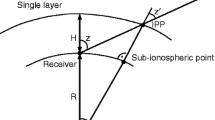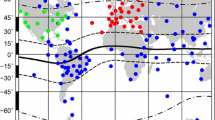Abstract
The performance of a three-dimensional ionospheric electron density model derived from FormoSat3/COSMIC GPS Radio Occultation measurements, called the TaiWan Ionosphere Model (TWIM), in removing the ionospheric delays in single-frequency pseudorange observations is presented. Positioning results using TWIM have been compared with positioning results using other ionospheric models, such as the Klobuchar (KLOB) and the global ionospheric model (GIM). C/A code pseudoranges have been observed at three International GPS Service reference stations that are representative of mid-latitude (BOR1 and IRKJ) and low-latitude (TWTF) regions of the ionosphere. The observations took place during 27 geomagnetically quiet days from April 2010 to October 2011. We perform separate solutions using the TWIM, KLOB, GIM ionospheric models and carry out a solution applying no ionospheric correction at all. We compute the daily mean horizontal errors (DMEAN) and the daily RMS (DRMS) for these solutions with respect to the published reference station coordinates. It has demonstrated that TEC maps generate using the TWIM exhibit a detailed structure of the ionosphere, particularly at low-latitude region, whereas the Klobuchar and the GIM only provide the basic diurnal and geographic features of the ionosphere. Also, it is shown that even for lower satellite elevations, the TWIM provides better positioning than the Klobuchar and GIM models. Specifically, using TWIM, the difference of the uncorrected solution (no ionospheric correction), and the other solutions, relative to the uncorrected solution, is 45 % for the mean horizontal error (DMEAN) and 42 % for the horizontal root-mean-square error (DRMS). Using Klobuchar and GIM, the percent for DMEAN only reaches to about 12 % and 3 %, while the values for the DRMS are only 12 and 4 %, respectively. In the vertical direction, all models have a percentage of about 99 and 70 % for the mean vertical error (VMEAN) and vertical root-mean-square error (VRMS), respectively. These percentages show the greater impact of TWIM on the ionospheric correction compared to the other models. In at least 40 % of the observed days and across all stations, TWIM has the smallest DMEAN, VMEAN, DRMS, and VRMS daily values. These values reach 100 % at station TWTF. This shows the overall performance of TWIM is better than the Klobuchar and GIM.









Similar content being viewed by others
References
Allain DJ, Mitchell CN (2009) Ionospheric delay corrections for single-frequency GPS receivers over Europe using tomographic mapping. GPS Sol 13:141–151
Camargo PDO, Monico JFG, Ferreira LDD (2000) Application of ionospheric corrections in the equatorial regions for L1 GPS users. Earth Planets Space 52(1):1083–1089
Conley R, Cosentino R, Hegarty C, Kaplan E, Leva JL, de Haag M, Van Dyke K (2006) Performance of standalone GPS. In: Kaplan ED, Hegarty C (eds) Understanding GPS: principles and applications. Norwood, MA, pp 237–319
Klobuchar JA (1987) Ionospheric time-delay algorithm for single-frequency GPS users. IEEE Trans Aerosp Electron Syst AES 23(3):325–331
Ovstedal O (2002) Absolute positioning with single-frequency GPS receivers. GPS Sol 5(4):33–44
Spencer J, Frizzelle BG, Page PH, Voger JB (2003) Global positioning system: a field guide for the social sciences. Blackwell Publishing Ltd, Oxford
Tsai LC, Liu CH, Hsiao TY, Huang JY (2009) A near real-time phenomenological model of ionospheric electron density based on GPS radio occultation data. Radio Sci 44:RS5002. doi:10.1029/2009RS004154
Author information
Authors and Affiliations
Corresponding author
Rights and permissions
About this article
Cite this article
Macalalad, E.P., Tsai, LC., Wu, J. et al. Application of the TaiWan Ionospheric Model to single-frequency ionospheric delay corrections for GPS positioning. GPS Solut 17, 337–346 (2013). https://doi.org/10.1007/s10291-012-0282-8
Received:
Accepted:
Published:
Issue Date:
DOI: https://doi.org/10.1007/s10291-012-0282-8




